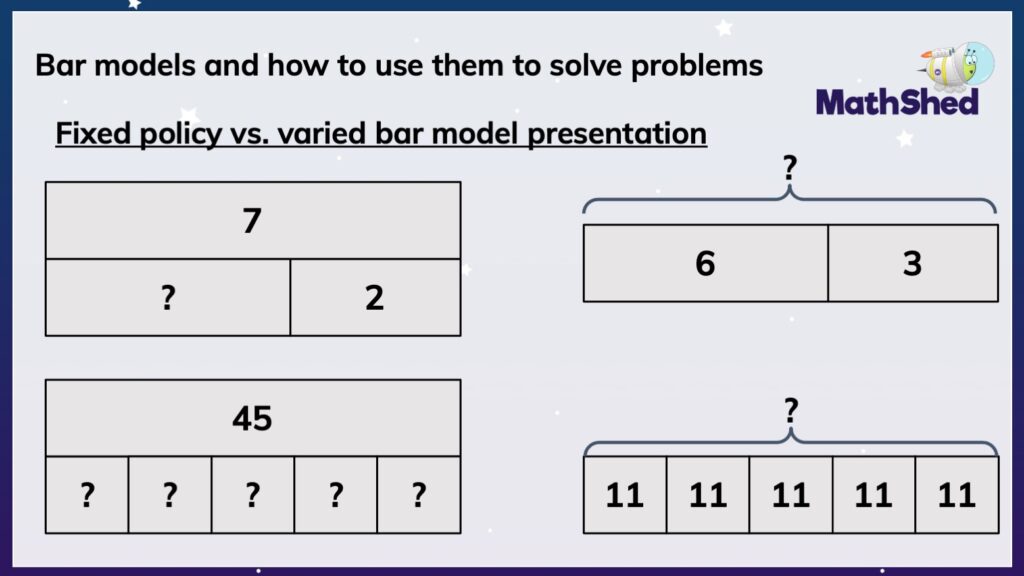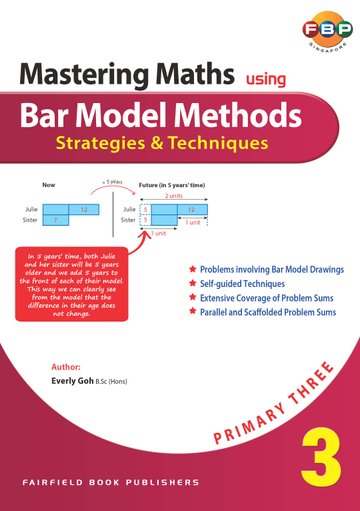A simple guide to understanding math better through bar model drawing techniques
Wiki Article
Exploring Bar Model Drawing Techniques: A Comprehensive Overview to Picturing Math Concepts
Bar model drawing techniques work as a valuable source for both teachers and students in picturing mathematical ideas. These designs simplify complicated mathematical relationships, assisting in the comprehension of addition, division, subtraction, and reproduction. This overview describes efficient strategies for carrying out bar designs, cultivating energetic engagement and real-world links. As readers explore the sensible applications and training tips, they will certainly reveal exactly how these strategies can transform their strategy to maths.Recognizing the Fundamentals of Bar Model Illustration
Bar design drawing acts as an effective aesthetic tool in mathematics, assisting in the understanding of numerical relationships and analytical methods. This strategy entails representing numbers and their partnerships through rectangle-shaped bars, making it simpler to imagine procedures such as addition, reduction, department, and multiplication. Each bar's length represents a details value, allowing learners to contrast amounts and comprehend percentages clearly.To produce a bar model, one begins by determining the trouble's essential elements, frequently damaging it down right into components that can be aesthetically stood for. In an easy enhancement problem, 2 bars can be attracted, with their sizes representing the addends. The mixed size shows the sum. In addition, bar versions can be adjusted for more complicated issues, including fractions and ratios, by readjusting benches accordingly. Mastering these fundamentals lays a solid structure for reliable analytical and much deeper mathematical comprehension.
Advantages of Utilizing Bar Versions in Math
Utilizing bar designs in mathematics provides countless benefits that enhance understanding and comprehension. These graphes help students in understanding complex principles by breaking them down right into manageable elements. Bar designs offer a clear structure for illustrating partnerships in between numbers, making abstract ideas much more concrete. They advertise a much deeper understanding of mathematical operations and promote analytical by allowing students to envision the data they are functioning with.Bar models sustain the development of essential believing skills, as pupils must assess and translate the visual information to attract final thoughts. This approach motivates active interaction with the product, reinforcing retention and mastery of mathematical concepts. By fostering a strong structure in aesthetic proficiency, bar designs equip learners to come close to various mathematical difficulties with self-confidence. Generally, the combination of bar models into maths education and learning shows valuable in growing both understanding and logical capacities amongst pupils.
Using Bar Versions to Addition and Subtraction
Bar versions function as a reliable device for aesthetically representing enhancement and reduction troubles. By showing the partnership between numbers, they boost understanding and promote analytic. On top of that, real-life applications of these designs can help students realize mathematical concepts in practical contexts.Representing Addition Visually
Visual aids can substantially enhance their understanding of these operations when trainees run into addition and reduction problems. Bar versions offer as efficient tools for standing for enhancement. By splitting a rectangle into sectors that represent the numbers entailed, trainees can imagine the partnership in between the amounts. As an example, if a pupil needs to add 3 and 5, they can develop a bar separated right into 2 areas: one area representing 3 and the other standing for 5. This clear depiction not just simplifies the addition procedure but additionally reinforces the concept of incorporating quantities. As students manipulate these visual help, they develop a deeper understanding of addition, bring about enhanced analytic skills and better confidence in their mathematical abilities.
Subtraction With Bar Designs
Subtraction is usually perceived as an extra complicated operation than enhancement, bar models can properly clarify this procedure for students. By aesthetically representing the amounts included, pupils can much better understand just how numbers associate with each other. In a bar model for subtraction, one bar stands for the total amount, while another shows the quantity being deducted. This aesthetic difference aids students understand the concept of "taking away." For example, if a bar reveals 10 devices, and an additional bar representing 4 systems is removed, trainees can easily see that 6 devices stay. This technique not only cultivates understanding of reduction however likewise aids in developing analytic skills, enabling pupils to envision their mathematical thinking and enhance their total understanding of mathematical ideas.Real-Life Application Examples
Understanding subtraction with bar designs lays a structure for applying these methods in real-life scenarios. In various contexts, such as budgeting or purchasing, individuals can visualize just how much cash remains after expenditures. For example, if an individual has $50 and invests $20, a bar design can stand for the complete amount and the spent section, illustrating that $30 is left. Additionally, moms and dads can make use of bar models to assist children recognize the number of even more items require to be added to finish a set, such as having three apples and requiring 5. This graph streamlines complex troubles, assisting in comprehension and retention. Eventually, bar versions function as reliable devices in everyday decision-making, boosting mathematical understanding in useful scenarios.Picturing Reproduction and Division With Bar Versions
In exploring the application of bar models for multiplication and division, it is important to grasp their foundational ideas. Constructing reproduction versions allows learners to picture relationships between numbers, while efficient department strategies can be shown with these aesthetic help. This technique boosts comprehension and analytical abilities in maths.Comprehending Bar Versions
Bar models serve as an effective aesthetic tool for highlighting the principles of multiplication and department. They allow students to represent mathematical connections in an organized format, assisting in a much deeper understanding of these procedures. In reproduction, bar versions present teams of equal dimension, allowing people to envision the complete quantity when combining these teams. Conversely, in department, bar versions assist illustrate just how an overall is divided into smaller sized, equal parts, making clear the idea of partitioning. By utilizing these aesthetic aids, students can comprehend the underlying concepts of multiplication and division better. This approach not only improves understanding but additionally sustains problem-solving abilities, making bar models an invaluable asset in mathematical education and learning.Creating Multiplication Designs
Building reproduction models utilizing bar layouts uses a clear approach for picturing the procedure of multiplication. These versions allow learners to stand for reproduction as teams of equivalent parts, making abstract ideas more concrete. To illustrate (3 times 4), a pupil can draw one bar split into 3 equivalent sectors, each representing 4 units. In addition, creating a 2nd bar with the exact same size strengthens the understanding of repeated addition, as each segment matches to one team. This aesthetic representation not only help in comprehending multiplication but likewise improves problem-solving abilities. By utilizing bar versions, trainees can much better comprehend relationships between numbers and create a robust structure for extra intricate mathematical principles, bring about raised confidence in their capabilities.Envisioning Department Methods

Fixing Word Issues Utilizing Bar Model Techniques

As an example, in an issue involving addition and reduction, students can draw different bars for every quantity and after that adjust them to discover the solution. This procedure not only clarifies the problem yet also fosters a deeper conceptual understanding. Moreover, bar designs can be adjusted for different kinds of word issues, making them flexible across different mathematical topics. Inevitably, utilizing bar designs can significantly boost students' analytical abilities by offering a clear visual pathway to show up at the click here proper response.
Integrating Bar Designs in Various Mathematics Topics
Bar models can be seamlessly incorporated right into various mathematics topics, improving students' understanding of ideas past fundamental arithmetic. In algebra, these visual devices aid in standing for equations and inequalities, enabling learners to visualize partnerships in between variables. When taking on geometry, bar versions can highlight the residential or commercial properties of shapes and spatial thinking, assisting trainees realize principles like location and boundary effectively. In stats, bar designs facilitate the analysis of data collections, permitting pupils to compare amounts and recognize patterns visually. Additionally, incorporating bar designs within measurement subjects help in understanding systems and conversions by providing a concrete depiction of quantities. By utilizing bar versions throughout various mathematical locations, instructors can promote a deeper understanding of complex ideas, consequently improving problem-solving abilities and promoting essential thinking (bar model drawing techniques). This adaptability shows the utility of bar models as a foundational tool for trainees in their mathematical journeyTips for Mentor Bar Designs Properly
Incorporating bar models into mentor methods calls for thoughtful techniques to optimize their efficiency. Educators should start by presenting bar models with simple, relatable instances that students can easily grasp. This helps to build confidence and experience with the principle. Progressively raising the complexity of problems allows learners to apply their skills gradually. Furthermore, teachers should encourage students to produce their own bar versions, promoting energetic engagement and ownership of their learning.Incorporating collaborative tasks can likewise boost understanding, as students review and resolve problems in teams. Constant feedback is necessary; teachers must give positive commentary on pupils' bar version depictions to guide enhancement. Ultimately, linking bar designs to real-life scenarios strengthens their importance, assisting students see the sensible applications of their mathematical abilities. By implementing these methods, teachers can efficiently harness the power of bar versions in their mathematics guideline.
Frequently Asked Inquiries
Can Disallow Versions Be Made Use Of in Various Other Subjects Besides Math?
Bar versions can without a doubt be utilized in different topics past math. They successfully illustrate principles in science, social research studies, and language arts, helping to aesthetically represent partnerships, procedures, and ideas for improved understanding throughout disciplines.What Age Group Is Ideal Matched for Knowing Bar Versions?
Bar designs are best matched for youngsters ages 7 to 12, as they create concrete thinking abilities throughout this period (bar model drawing techniques). At this age, pupils can properly grasp abstract principles with visual depiction and analytical methodsExist Digital Devices for Creating Bar Versions?

Exactly How Can I Evaluate Pupil Comprehending of Bar Designs?
Examining student understanding of bar versions can include tests, empirical evaluations, and group conversations. Teachers may also examine students' finished models and their capability to discuss their reasoning, ensuring a complete analysis of understanding.What Are Typical Mistakes When Making Use Of Bar Models?
Typical errors when using bar models include misstating amounts, falling short to accurately label bars, confusing enhancement and reduction, neglecting to use consistent scales, and overlooking the value of clear visual splitting up in between different aspects.In enhancement, bar designs can be adjusted for more complex issues, consisting of portions and ratios, by changing the bars as necessary. Reduction is frequently perceived as a more complicated operation than addition, bar versions can efficiently clarify this procedure for students. In a bar model for reduction, one bar stands for the total amount, while another indicates the quantity being deducted. If a bar reveals 10 units, and one more bar standing for 4 systems is gotten rid of, pupils can quickly see that 6 units stay. When separating an overall into equivalent groups, trainees can attract a long bar to stand for the entire and after that segment it right into smaller bars that show each group.
Report this wiki page